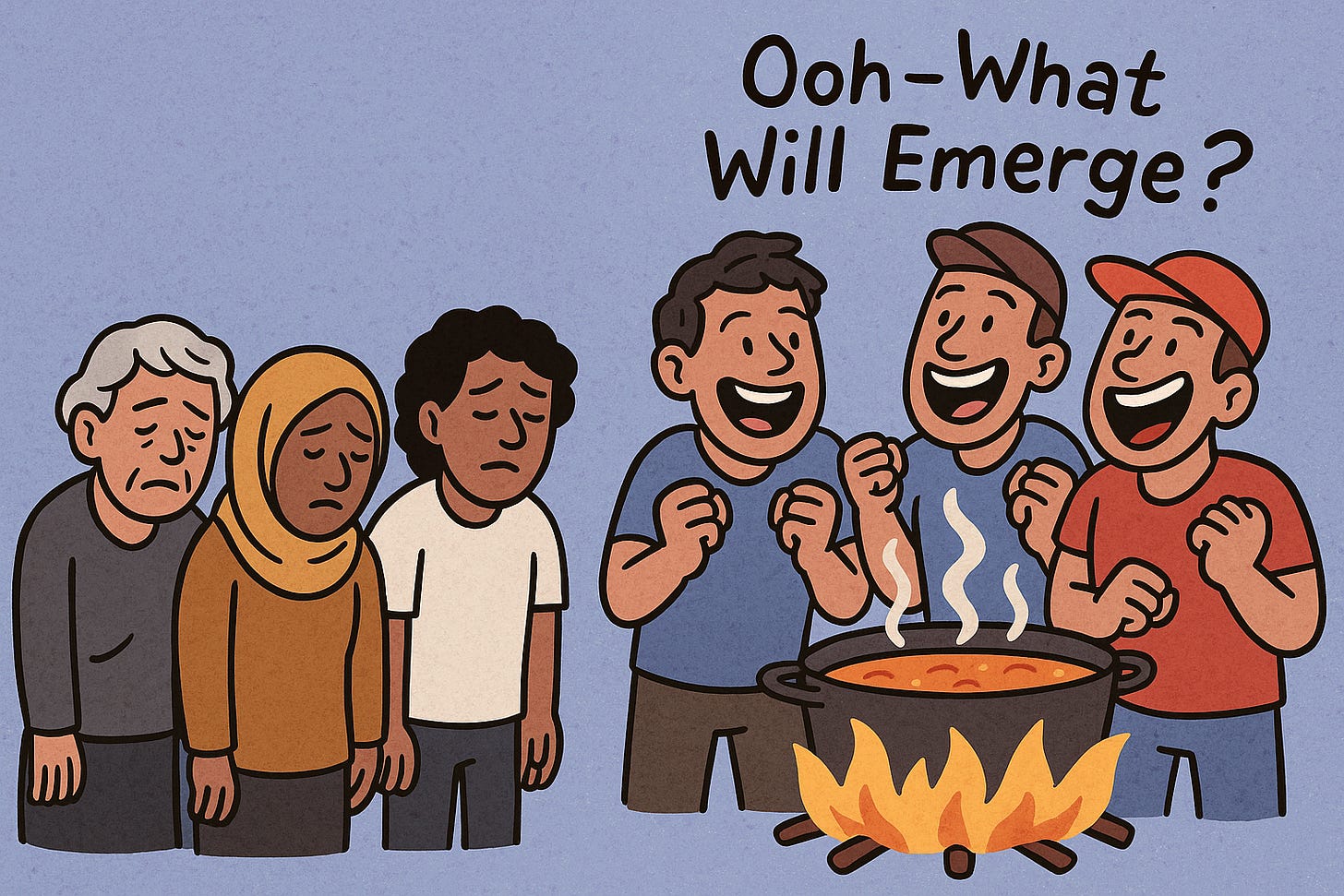Emergence Is an Excuse: Toward a Forensic Ethics of System Design
When systemic harm is repeated, profitable, and structured, complexity is not an explanation. It’s an alibi.
We’re often told that injustice “emerges” from complexity—that no one meant harm, no one can be held accountable. Yet from hospitals to welfare offices, disaster funds to high-school admissions, exclusion is engineered through proxies, thresholds, contracts, and automated rules. To dismantle systemic injustice today, we must move beyond mapping emergent patterns and toward reconstructing intentional design.
How “Emergence” Became an Alibi
When an earthquake kills hundreds but triggers no disaster relief because it missed a GPS threshold by two miles, complexity is not the story. Contract design is.
In policy halls, academic journals, and tech boardrooms, emergence has become a shield. Models adapt. Networks shift. Feedback loops spiral. When harm follows, we’re reassured it was unintended—“just the way the system works.”
This sophistication obscures choice. Which proxy stood in for human need? Who drew the cutoff line? Who coded the filter to safeguard profit?
Patterned exclusion, traceable along racial and economic fault lines, isn’t surprising. It’s pre-planned.
When the same communities are repeatedly cut out—and when denial flows directly into institutional profit—we don’t need theories of unpredictability. We need forensic reconstruction.
Four Case Studies of Authored Exclusion
Across sectors, harm isn’t discovered after deployment. It’s embedded from the start—through procurement, optimization, and risk modeling.
A 2019 Science study revealed that a widely used healthcare risk algorithm systematically under-prioritized Black patients. The cause? It used future healthcare spending as a proxy for medical need—baking historical inequities into resource allocation. (Obermeyer et al., Science, 2019)
The same pattern emerges in public services:
Indiana’s $1.3 billion IBM contract introduced automated denial scripts that treated missing paperwork as fraud triggers. Thousands lost benefits not by accident, but through policy structured into the system’s design. A $78 million settlement confirmed that this harm was contractual, not accidental. (Associated Press, 2019)
In financial engineering, the same architecture reappears:
Following two major earthquakes in 2017, Mexico’s World Bank–backed catastrophe bond paid out for an 8.1-magnitude quake—but not for a deadlier 7.1 quake near Puebla. Why? Because the latter fell just outside the bond’s narrowly drawn parametric box. (Artemis.bm, 2017)
Relief was not distributed according to need. It was distributed according to contract clauses.
Even in education, design decisions replicate harm:
New York City’s high-school admissions algorithm weighted cut-scores and priorities that systematically filtered out Black and Latinx students. The system's design, not its size, reproduced segregation patterns. (The Markup, 2021)
The Anatomy of Designed Harm
The instruments of exclusion are technically simple, politically potent:
Proxy Variables: Using biased stand-ins like spending instead of need.
Parametric Triggers: Setting narrow thresholds that deny aid even amidst devastation.
Contractual Exclusions: Writing out liability at the procurement phase.
Automated Gatekeeping: Codifying friction that preemptively denies access.
Cut-Score Weights: Embedding advantage through numerical screens.
These are not bugs. They are planned architectures of abandonment.
Code is policy. Contracts are strategy. Thresholds are politics.
Why “Conditional Emergence” Still Fails
Some argue that harm is conditionally emergent—an unintended consequence arising only under certain systemic constraints. But those constraints—proxy selections, trigger rules, threshold cutoffs—are themselves human decisions.
If a numeric cutoff predictably denies relief, that cutoff is policy—not fate.
Conditional emergence is not an excuse. It is simply a rebranding of design as accident.
From Systems Talk to Forensic Accountability
Mapping influence networks is necessary. But it is not sufficient.
Real accountability demands a forensic method:
Follow the Procurement: Who issued the contract? What exclusions were priced in from the beginning?
Inspect the Inputs: Which proxies were selected—and which forms of social knowledge were erased?
Expose the Thresholds: Who set the numerical barriers, and to what end?
Trace the Profits: Where does margin accumulate when access is denied?
Every system leaves a paper trail: contracts, risk models, marketing materials, optimization reports. Discovery—not diagnosis—is the method of justice.
Emergence Is an Excuse
Complexity is real. But when harm is repeated, profitable, and predictable, calling it emergent is complicity.
Actor-Network Theory helped reveal that agency is distributed. But if critique stops at mapping flows without tracing commissions, it becomes a theory of mystification.
Harm doesn’t just happen. It’s scoped, signed, coded, and sold.
To dismantle engineered exclusion, we must stop admiring the complexity of systems—and start reconstructing the architecture of harm.
Where there is pattern, there is authorship.
Where there is profit, there is commission.
Where there is denial, there is design.
The evidence is in the file trail. Are we ready to follow it?
Notes & References
Obermeyer, Z., Powers, B., Vogeli, C., & Mullainathan, S. (2019). "Dissecting racial bias in an algorithm used to manage the health of populations." Science.
Associated Press. (2019). "IBM owes Indiana $78 million over welfare automation services, court says."
Artemis.bm. (2017). "Mexico confirms $150 million cat bond payout after Chiapas quake; Puebla event missed trigger."
The Markup. (2021). "How We Investigated NYC High School Admissions."




